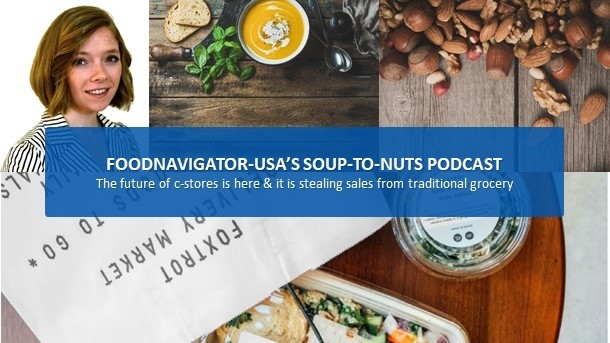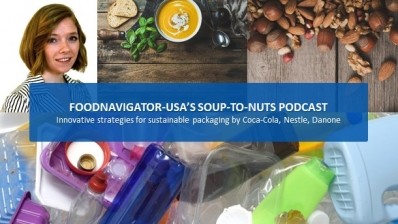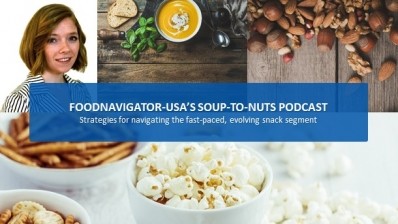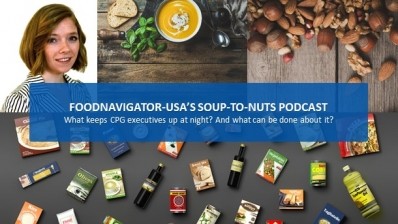Soup-To-Nuts Podcast: Elevated c-stores steal grocery sales as they welcome premium consumers, local brands

Foxtrot, and others like it, are redefining what a corner store and café can be by creating a welcoming environment not only for more premium shoppers, but also new brands from startups that may not yet have a high-profile distributor. Foxtrots also stands apart from the conventional c-store as a digitally-native store that offers a fully integrated ecommerce platform and delivery in under an hour for those consumers who don’t want to venture out but still need a few essentials.
By embracing new brands, ecommerce and other updates, Foxtrot and other similar convenience stores are starting to steal market share from traditional grocery stores. According to research released late last year by Inmar Intelligence, sales at convenience stores climbed 2.2% to $201.7 billion in 2018 from 2017 even though the number of stores fell 1.1%. At the same time, ecommerce sales of food increased 21.7% to $58b in 2018 from 2017, according to the research. This one-two punch is taking a toll on traditional grocery sales, which fell 1.1% to $547.6b in 2018 from 2017 and market share, which dropped 1.7% to 43.8% from 2017.
These numbers – and the potential for even more growth in the future – also are attracting the attention of investors, which could help exponentially move the needle towards omnichannel and convenience even more.
In this episode of FoodNavigator-USA’s Soup-To-Nuts podcast, Foxtrot co-founder and CEO Mike LaVitola discusses how a recently announced $17m investment will help Foxtrot continue to trailblaze a new path for c-stores both online and at brick-and-mortar stores. He also shares strategies for how Foxtrot effectively manages both sales channels to create a seamless shopping experience that better meets the needs of modern shoppers than more traditional models. Finally, he outlines the company’s approach to merchandising and the opportunities it is creating for new brands just starting out.
[Editor’s note: Never miss another episode of FoodNavigator-USA’s Soup-To-Nuts podcast – subscribe on iTunes.]
Balancing online with brick & mortar for a winning combination
When LaVitola helped co-found Foxtrot roughly five years ago as an online convenience store, he said his goal was to redefine how consumers thought about c-stores, and as the company grew – and expanded into brick & mortar – he said saw the full potential for an omnichannel “corner store” emerge.
“When I launched Foxtrot, like five years ago now, the idea was to take the old stodgy store, which if you think about from the traditional community landscape is not the most inspiring place … and bring that experience online and remerchandise all those traditional convenient categories,” to offer consumers a more convenient convenience store, he said.
About three years ago, Foxtrot expanded into brick & mortar with a seamless connection to its online platform so that it could meet the consumer wherever they are, he added.
Foxtrot’s duel channel strategy and fresh approach to merchandising is paying off as more consumers gravitate towards the retailer and its revenue continues to climb. Since, its launch, Foxtrot has grown its ecommerce base 150% year-over-year and its revenue 2x year-over-year.
It also is poised to expand its physical footprint with the help of the most recent funding round. The expansion will include two brick-and-mortar stores in Washington, DC, this spring, and its eighth location in Chicago – bringing its total store count to 12 across Chicago, DC and Dallas.
Small perks offer big rewards
LaVitola says Foxtrot’s growing fan base and retail reach is possible in part because of consumer word of mouth, but it is also thanks to a strategic business decision to court customers with a loyalty “perks” program.
“Our best customers, who are the customers in our loyalty program, are shopping with us an average of 10 times a month, which is really quite crazy for a retailer,” LaVitola said. But, he added, they do so because the store is where they need to be – online and offline.
Loyalty program members also are encouraged to come into the store with the offer of free coffee and to order online with free shipping, LaVitola said.
“Once you remove the friction of a deliver fee, then the value proposition is super, super strong,” he said, adding that the promise of coffee also helps tip the balance for consumers to come into the store for something they might want, if not need.
Foxtrot’s decision to offer free delivery is one that weighs on many retailers playing in the ecommerce space, because as LaVitola acknowledges “free isn’t free.” But, he explains, Foxtrot’s omnichannel approach gives it more flexibility to offer this benefit to consumers.
LaVitola added that the new infusion of investment funding also will allow Foxtrot to expand its perks program to offer additional benefits to loyal consumers beyond free coffee and free delivery.
Curated product offerings attract consumers
Another fundamental element of Foxtrot’s success has been its curated product offerings, which LaVitola says balance “old favorites” that shoppers expect at a corner store along with more innovative products from local makers.
Sourcing and stocking such a diverse mix isn’t easy, and LaVitola said a portion of the recent fundraise will go to hiring marketing and merchandising staff who can discover new brands that help drive foot traffic in brick & mortar while also meeting the needs of online shoppers who might favor products with which they are already familiar.
“We are out there all the time trying to find the absolute best product in each category. And, you know, sometimes that might be an old favorite like Oreos, it is hard to beat Oreos. But a lot of times there is someone local that is doing something better, fresher, more innovative and we want to highlight those as well,” LaVitola said.
He added that Foxtrot created its own back-end inventory and supply management system, which allows it to work with startups or companies that offer only one or two products – a notable difference from most convenience store chains that favor large distributors and only reevaluate their sets every other year.
In addition to a unique assortment of CPGs, LaVitola said, Foxtrot sets itself apart from other convenience stores by offering an elevated food service experience.
The key to ongoing success is relevancy
Looking forward, LaVitola says the future of Foxtrot – and likely food retail more generally – is about finding a balance across channels to remain relevant and meet consumers’ evolving needs.
“Consumers have so many different ways to shop and because e-commerce experiences are so rich, you need to have a really compelling reason to get people to leave their house and go into your store,” He said. “So, that means a menu or product that you can only get at stores, a hospitality driven environment,” and online and in-store experience that complement each other.










